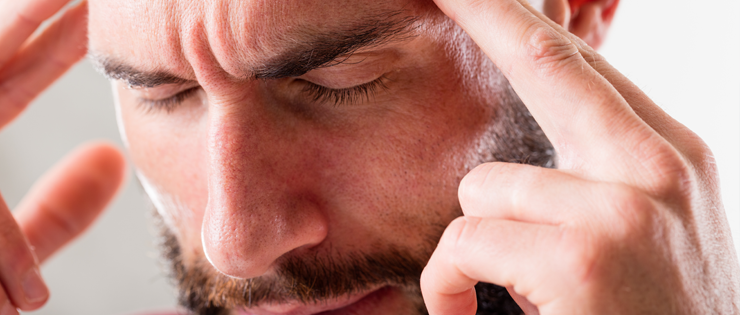
Ask anyone who suffers from migraines and they will describe them as ‘the world’s worst headache’. But what exactly are they, and what do you need to know about these bad boys of the headache world?
Dr Sam Hay explores the basics of migraines.
Migraine is a common episodic disorder, the centerpiece being severe disabling headaches, generally associated with nausea, and or light and sound sensitivity.
Overall 12% of Aussies are estimated to suffer a migraine - that’s nearly three million people – at some stage in their life, but I’m sorry ladies, it’s worse for you.
Only 6% of men suffer an ‘attack’ each year, compared to a whopping 17% of women. Striking most commonly in our thirties, migraines carry significant social, economical, and personal consequences.
Sadly, 2% of Aussie adults suffer ‘chronic migraines’, with attacks occurring over half the days of EVERY month.
So let’s look a little closer at what a migraine is.
Migraine sufferers generally experience recurrent attacks, which unfold as a cascade of events, usually over a few hours or days.
The beginning bit or ‘prodrome’. Most people get a day or two of relatively vague symptoms before the headache appears. Yawning, mood change (both up and down), irritability, constipation, cravings, and neck stiffness predominate.
The ‘aura’. Following the prodrome, about 25% of people experience some strange focal symptoms, just before or at the beginning of the headache.
Typical symptoms can be:
- Visual – Bright lights, shapes, or lines. These are the most common ones.
- Auditory – ringing, noises, or even music (imagine AC/DC blasting in your ear, brings new meaning to being Thunderstruck!).
- Sensory – pain, burning or tingling skin.
- Motor – Jerking or rhythmic movements.
Or, people can suffer the opposite of these, with symptoms such as loss of vision or hearing, loss of sensation or movement, or even symptoms such as word-finding-difficulty.
The headache. Classically one sided, throbbing and gradually increasing, the migraine headache is terrible. Building over the course of one to several hours, people frequently experience nausea and sometimes vomiting, with many reporting sensitivity to light or sound (photophobia or phonophobia). This all usually necessitates a good liedown in a dark and quiet room.
Wait, there’s more. The ‘prodrome’. Once resolved some experience flashes of pain if they move their head too quickly, which tends to occur in the same location as the original headache. Lastly, sufferers are just wiped out and exhausted, lasting hours or even days.
So what can people do to avoid a migraine?
Most sufferers report at least one trigger for their migraines, which forms the basis for prevention. Whilst it might be hard to identify everything, keeping any trigger in check goes a long way to reducing migraine frequency and severity. The most common triggers are:
- Emotional stress.
- Hormonal changes in women (eg some suffer every cycle).
- Skipping meals.
- Weather changes, or overheating.
- Sleep pattern changes, especially getting to bed late.
- Odours and smells.
- Neck pain and stiffness.
- Alcohol (mostly wine), or certain foods.
- Exercise, and frustratingly for some – sex!
Struggling with your weight? Then you just might be making your migraines worse, with obesity linked to increased severity and frequency of attacks.
So what can we do if we have an attack?
People worried about migraines need to pop into their general practitioner for a check up. Whilst the attacks can often appear ‘classic’, there are a few more serious conditions that need to be ruled out. This is even more important if migraines are new to you.
For chronic (or at least frequent) sufferers, there are a number of medications that can be prescribed to help prevent attacks – your GP can explore these with you, tailoring the right treatment to your needs. It’s expected that at least 50% of people will have at least a 50% reduction in migraine concerns, however, side effects are common which makes things all the more tricky.
‘Abortive therapy’. The primary aim is to ‘abort’ any migraine, with options ranging from simple analgesics, to specialized drugs. And of course, all triggers need careful management.
As GPs we generally encourage patients to trial simple over-the-counter options, as these are cheap and easily accessible. Based on good solid evidence I usually recommend a dose of:
NSAID (non-steroidal anti-inflammatory drug). For example aspirin, ibuprofen, or naproxen. In fact, it is recommended to take these in a slightly higher (one off) dose than usual (eg 3-4 aspirins or 2-3 ibuprofen 200mg tablets).
A dose of paracetamol (two tablets).
Plenty of fluids and a rest.
NSAIDs or paracetamol can be effective treatments on their own, but most will get extra benefit from both.
Failing these, and following suitable investigations and check ups, we might offer anti-nausea tablets if nausea or vomiting are a feature, or specific anti-migraine drugs such as Triptans.
Triptans are effective for the acute management of migraines as they target the mechanism for why migraines arise, rather than just treating the symptoms. They are safe, have few side effects, but there are a few precautions that need checking with your doctor before you just go and give them a go. Plus, they aren’t cheap, so if you’re struggling with a migraine, make sure you’ve done all of the simple things first.